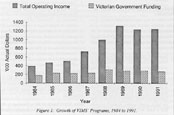


A Consortium Approach to Marine Science
Introduction
The Origins of VIMS and Its Consortium Approach
Benefits and Problems of a Consortium Approach
Realizing the Benefits, Overcoming the Problems
VIMS' Role in the Consortium
Building on the Consortium Approach
Conclusion
References
Index
Search
Help
Contact us

Figure 1 shows the total annual operating income to VIMS in the last 8 years, against which is set that proportion which derives from Victorian government appropriation. It highlights several points:
- the growth, at about 25% compounding annually, in the second half of the 1980s. The plateau in the last 2 years may be in part related to the current recession but, as I shall explain later, is also linked to the increasing effectiveness of the consortium approach.
- the increasing self-sufficiency, whereby Victorian government funding has declined slightly in real terms and growth of programs has been funded entirely by external sources. These include a mix of competitive grant funds, contract research, and fees for scientific/educational services. VIMS' ability to achieve 80% self-sufficiency, a level which is virtually umnatched by other research agencies in Australia, while retaining its reputation for excellence and its focus on basic as well as applied research, also is linked to the effectiveness of the consortium approach.

Organisations in Australian Science at Work - Victorian Institute of Marine Sciences
 |
Royal Society of Victoria |  |
© Copyright of Australian Science and Technology Heritage Centre and The Royal Society of Victoria 2001
Published by Australian Science and Technology Heritage Centre, using the Web Academic Resource Publisher
http://www.austehc.unimelb.edu.au/smv/079.html